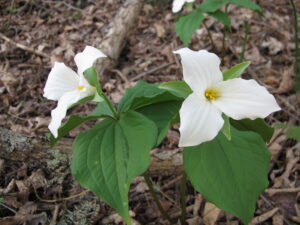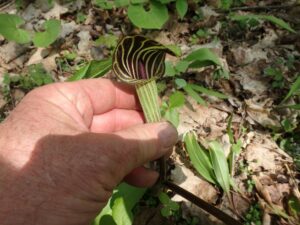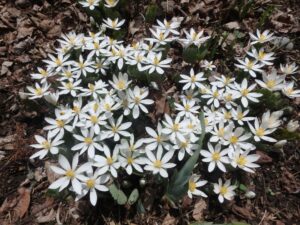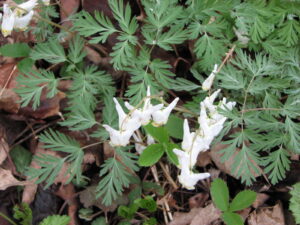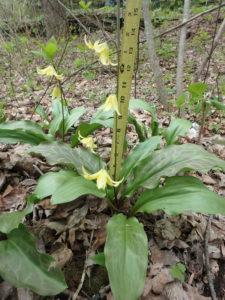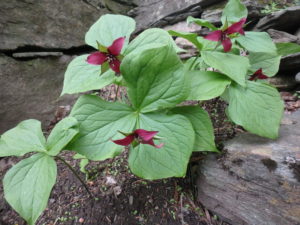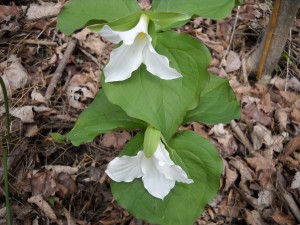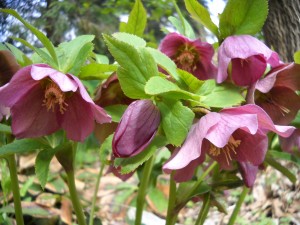Six Wildflowers You Should Grow
One of my favorites is Trillium. That is both a scientific name and a common name, though the common wine red species, Trillium erectum, is also called Purple Trillium, Wake-robin and Stinking Benjamin. It does best in light shade and acidic soils. Its flower has three petals and stands up above the foliage. As it matures over the years, the clumps get bigger. A related species, T. grandiflorum, or white trillium is similar in looks, but with white petals that fade to pink. It’s very lovely.
Hepatica is one of the earliest wildflowers to bloom in my woods. The common name, Hepatica, is also the scientific name, though there are two similar species: H. acutiloba or Sharp-lobed Hepatica, and H. americana or Round-lobed Hepatica.
The leaves are dramatic. When they first appear, they are rolled up like a cigar, standing vertically in your forest duff. Later the leaves open and flatten out, getting large for a wildflower: six to eight inches wide. These persist much of the summer, creating a nice groundcover.
The foliage is as pretty as the flowers: it is finely cut, and reminiscent of its cousin, wild bleeding heart ( Dicentra exemia) which is sold everywhere as a shade perennial. When Dutchman’s Breeches dies back, the leaves just disappear without yellowing and lingering on, which is a nice feature. It does best in moist, rich soil in shade or part sun. The corms are tiny.
7 Wildflowers You Can Grow
Recently I was asked about plants for shady places. Wildflowers, I said, are wonderful in the woods or at the edge of the woods. Most show up early, before the leaves are on the trees. They are the perfect antidote to a long winter and rainy spring. They bring color and brightness just when we need it most.
Among the early wildflowers, blood root (Sanguinaria canadensis) is one of my favorites, and it is early. First it sends up a leaf rolled up like a cigar. Then the leaf opens to display a brilliantly white flower that is an inch or two inches across. The flowers stay closed on cool, cloudy days but open up for business when the sun comes out – and the pollinators.
If you have bloodroot in your woods and want some in your shade garden, the rhizomes (root structures) can be dug up and moved easily. But wear gloves! The roots produce a red sap which has been used for dyes, but it is highly toxic.
According to an article by Susan Mahr of the University of Wisconsin Master Gardener program, blood root sap is “an escharotic, a substance that kills tissue, and external application is a skin irritant causing severe burning pain and disfigurement.” She says to move bloodroot in mid-summer as the plants begin to go dormant, but before the leaves disappear.
A friend gave me a small clump of double bloodroot about 15 years ago, and it has spread nicely. It is a tetraploid, meaning it has double the number of chromosomes, and is sterile, making it rare and expensive. I have divided mine and now have it in several places. Each blossom looks like a tiny white peony.
Another one of my favorite wildflowers is Jack-in-the-pulpit (Arisaema triphyllum). Some are fully up now in my woods, while others are just poking up their noses. The flower is not very flower-like. There is a purple phallic-looking projection that looks up from the center of the plant that is sheltered by an overhanging flap of leaf-like growth. The two large leaves are distinct on tall stems. It does well in rich soil and dappled shade.
I’ve had great luck planting seeds of Jack-in-the-pulpit in mid-summer. They are bright red when ripe. If you want to harvest some, wear gloves as the seeds of Jack-in-the-pulpit, like bloodroot, contain toxic chemicals. The seeds need to be cleaned by mashing the pulp and washing it away before drying and planting. If you do so, you should see germination the following spring (but it will be 2 to 3 years before you see flowers).
Both bloodroot and Jack-in-the-pulpit seeds produce eliasomes. These are organs that are attractive to ants, who drag the seeds – complete with the fleshy white eliasomes – back to their nests. The ants eat the eliasomes, then dump the seeds in an ant trash pile, where they can germinate. That way the seeds can travel some distance. Clever!
Trout lily or dog tooth violets (Erythronium americanum) were common in the spring woods where I grew up in Connecticut. Each plant has one or two small canoe-shaped leaves that are spotted, like the belly of a trout. Younger plants have just one leaf and do not bloom. Mature leaves bloom now, or even earlier, with yellow lily-like blossoms with the petals and sepals bent backwards. The flowers stems grow about 6 inches tall.
Three years ago I bought bulbs for a western form of trout lily that is much more dramatic than our native one. I neglected to label the bulbs other than to say they were Erythronium. Studying examples on the web I see Erythronium grandiflorum as one possibility, or a hybrid called ‘Pagoda’. My blossoms are on 12 inch stems, and each plant produces multiple blossoms. Definitely a fine addition to my woodland garden.
Trillium is a genus (botanical group) that includes several nice, easy-to-grow wildflowers. The red or purple trillium (Trillium erectum) is also known as wake-robin or stinking Benjamin for its earthy smell. It does well in dappled shade and rich, dark soil. I also grow a white trillium (Trillium grandiflorum) that grows alongside it. The white one turns pink later in the spring. Several other species exist, and are available from nurseries and specialty nurseries on-line.
One of the best sources for all of these wild flowers is from The Garden in the Woods in Framingham, Massachusetts. The Garden in the Woods is a garden, education center and plant nursery run by The Native Plant Trust, formerly called the New England Wild Flower Society. They sell potted perennial wildflowers, native trees and shrubs, and much more. Now is a great time to visit them to see what you might grow in your own woods.
Henry is the author of 4 gardening books. You may e-mail him at henry.homeyer@comcast.net.
Spring Flowers
I love spring. Winter is relatively austere time in the garden so I relish the bounty of spring all the more. Over the years I have tried growing most flowers that will provide color in March, April and May. Below are some of my favorites.
First to bloom are the bulb flowers that begin the spring show in March. I have thousands of snowdrops (Galanathus elwesii), squill (Scilla siberica), glory of the snow (Chionodoxa luciliae). These are followed in April by crocus, daffodils and early tulips. I cut even the smallest blossoms to bring inside and place on the kitchen counter in a vase. Almost all the bulb plants are good cut flowers. I plant bulb plants every fall, and recommend top-dressing them with organic fertilizer after they finish blooming each spring.
Then come the early perennials, starting in April and continuing on into May. One of the first, and easiest to grow, is called lungwort. The unattractive name comes from the leaves, which some unfortunate person decided looked like lungs – complete with spots on most varieties. I prefer to call them by their Latin genus, Pulmonaria, which is more melodious.
Pulmonaria will grow in sun or shade, wet or dry. They spread by root, creating large low-growing colonies. I once had a gardening client who considered them invasive, though I do not. If they overstep their welcome, I find they pull fairly easily with my favorite weeding tool, the CobraHead weeder, which gets under them easily. The small flowers come in shades of blue, pink, peach and white. They don’t do well in a vase, so I don’t pick them.
Another spring favorite of mine is the hellebore, sometimes called the Lenten Rose. Hellebores are among the earliest to send up shoots of flowers and hold those flowers for several weeks. Each flower stalk stands 12 to 15 inches tall and supports new leaves and bell-shaped flowers that are rose to purple in color, or sometimes green and white. Like the Pulmonaria, they do not last well in a vase.
Primroses bloom early, and come in a wide range of species and colors. I have at least 6 different species in bloom now. One of my favorites has no common name, only going by its scientific name, Primula kisoana. Because its species name starts with “kis”, you can call it the kissing primrose – even if no one else does (except me). It has bright magenta-colored flowers that stand just a few inches above the light-green leaves. It is not very well known at nurseries; I found mine at Cider Hill Gardens in Windsor, VT (www.ciderhillgardens.com).
An endearing quality of Primula kisoana is that it spreads by root – but never runs over another plant to establish new territory. Primroses, in general, are form clumps but spread by seed. Some, like the candelabra primrose (Primula japonica) spread very vigorously by seed if the conditions are right for it. That one stands up over two-feet tall, but blooms much later, usually in June. But P. kisoana spreads fast if the soil conditions are right. One plant can grow to cover 1 to 2 square feet in a season. They like rich, dark soil with a slightly acidic pH.
 Most primroses grow well in light shade or morning sunshine and prefer moist soil. Primula kisoana, on the other hand, will grow in dry soil, too. I have observed that one of the best places to grow any primrose is under an old apple tree. The soil and light there generally is perfect for primroses.
Most primroses grow well in light shade or morning sunshine and prefer moist soil. Primula kisoana, on the other hand, will grow in dry soil, too. I have observed that one of the best places to grow any primrose is under an old apple tree. The soil and light there generally is perfect for primroses.
Although it is contrary to the law to dig up wildflowers and transplant them to your property, many good garden centers are now propagating and selling them. In nature, most spring wildflowers grow in the dappled shade of a hardwood forest. They send up flowers and leaves before the trees have leafed out, and disappear soon after the forest becomes shady. Among my favorites are the trilliums, bloodroot, and hepaticas – though there are dozens of other species.
Bloodroot are so named for the red juice that oozes from the roots if cut. I’ve read that Indians used it for dye. The leaves come up wrapped like a cigar around the flower stalk. Each simple white flower stands 6 inches tall. The blossoms open on warm, sunny days and close up at night or on chilly days. They spread by root to form nice clumps. I also have some double bloodroot – the flowers resemble small white double peonies. The flowers are probably sterile, as they keep on blooming much longer than the singles. Most flowers stop blooming once fertilized, having done their work.
I have three species of trillium: the ordinary maroon one (Trillium erectum), the white one (Trillium grandiflorum) and the yellow one (Trillium luteum). All will grow in light shade or part sun and prefer rich, dark soil. The New England Wildflower Society (www.newfs.org) sells all three – and many other fine wildflowers at their headquarters, The Garden in the Woods in Framingham, MA. I bought my yellow trillium from them. In addition to its flower, it has handsome mottled leaves.
So visit your local garden center soon to see what early spring bloomers they offer, and try something new. You’ll be glad you did.
Henry Homeyer is a gardening consultant and the author of 4 gardening books. His Web site is www.Gardening-Guy.com.



